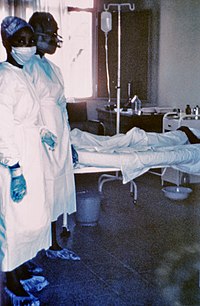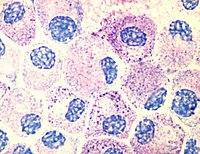
Lymphocyte Membrane‐ and 12p1‐Dual‐Functionalized Nanoparticles for Free HIV‐1 Trapping and Precise siRNA Delivery into HIV‐1‐Infected Cells (Adv. Sci. 10/2023)
Sign Up to like & getrecommendations! Published in 2023 at "Advanced Science"
DOI: 10.1002/advs.202370058
Abstract: Precise siRNA Delivery Precise delivery of siRNA into HIV‐1‐infected cells is realized by the lymphocyte membraneand 12p1‐dual‐functionalized nanoparticles. These nanoparticles also display the ability of trapping free HIV‐1 and inhibiting the gp120‐induced bystander T cell… read more here.
Keywords: hiv; infected cells; hiv infected; precise sirna ... See more keywords

Current strategies to induce selective killing of HIV‐1‐infected cells
Sign Up to like & getrecommendations! Published in 2022 at "Journal of Leukocyte Biology"
DOI: 10.1002/jlb.4mr0422-636r
Abstract: Although combination antiretroviral therapy (ART) has led to significant HIV‐1 suppression and improvement in immune function, persistent viral reservoirs remain that are refractory to intensified ART. ART poses many challenges such as adherence to drug… read more here.
Keywords: hiv; infected cells; current strategies; hiv infected ... See more keywords

miR‐150‐mediated increase in glucose uptake in HIV‐infected cells
Sign Up to like & getrecommendations! Published in 2020 at "Journal of Medical Virology"
DOI: 10.1002/jmv.26755
Abstract: Replication of HIV‐1 inside host cells is dependent on both viral and host factors. MicroRNAs are small noncoding RNAs that regulate protein synthesis. MicroRNAs may control viral replication either by directly targeting the viral genome… read more here.
Keywords: hiv; increase; mir 150; expression ... See more keywords

LANA regulates miR‐155/GATA3 signaling axis by enhancing c‐Jun/c‐Fos interaction to promote the proliferation and migration of KSHV‐infected cells
Sign Up to like & getrecommendations! Published in 2022 at "Journal of Medical Virology"
DOI: 10.1002/jmv.28255
Abstract: Kaposi's sarcoma (KS) is the second most common tumor in people infected with human immunodeficiency virus worldwide, but its pathogenesis is still unclear. In this study, we discovered that the expression of GATA‐binding protein 3… read more here.
Keywords: mir 155; kshv infected; jun fos; infected cells ... See more keywords

Upregulation of PD‐L1 by SARS‐CoV‐2 promotes immune evasion
Sign Up to like & getrecommendations! Published in 2023 at "Journal of Medical Virology"
DOI: 10.1002/jmv.28478
Abstract: Patients with severe COVID‐19 often suffer from lymphopenia, which is linked to T‐cell sequestration, cytokine storm, and mortality. However, it remains largely unknown how severe acute respiratory syndrome coronavirus 2 (SARS‐CoV‐2) induces lymphopenia. Here, we… read more here.
Keywords: immune evasion; cov promotes; promotes immune; infected cells ... See more keywords

Live Imaging of Virus-Infected Cells by Using a Sialidase Fluorogenic Probe.
Sign Up to like & getrecommendations! Published in 2021 at "Methods in molecular biology"
DOI: 10.1007/978-1-0716-1258-3_13
Abstract: Visualization of virus-infected cells is usually performed by immunostaining with an antiviral antibody. On the other hand, we established an easy method for fluorescence (FL) imaging of cells infected with influenza A and B viruses… read more here.
Keywords: probe; using sialidase; virus infected; sialidase ... See more keywords

Electron Microscopy of Ebola Virus-Infected Cells.
Sign Up to like & getrecommendations! Published in 2017 at "Methods in molecular biology"
DOI: 10.1007/978-1-4939-7116-9_19
Abstract: Ebola virus (EBOV) replicates in host cells, where both viral and cellular components show morphological changes during the process of viral replication from entry to budding. These steps in the replication cycle can be studied… read more here.
Keywords: electron microscopy; infected cells; ebola virus; microscopy ... See more keywords

Simultaneous detection of multiple viruses in their co-infected cells using multicolour imaging with self-assembled quantum dot probes
Sign Up to like & getrecommendations! Published in 2017 at "Mikrochimica Acta"
DOI: 10.1007/s00604-017-2300-6
Abstract: AbstractThe simultaneous detection and evaluation of the coinfection of a cell by multiple viruses or even multiple subtypes still is a difficult challenge. The authors introduce a method for simultaneous imaging, detection and quantitative evaluation… read more here.
Keywords: simultaneous detection; cells using; multiple viruses; infected cells ... See more keywords

A high-throughput detection method for the clonality of Human T-cell leukemia virus type-1-infected cells in vivo
Sign Up to like & getrecommendations! Published in 2020 at "International Journal of Hematology"
DOI: 10.1007/s12185-020-02935-5
Abstract: Approximately 10–20 million of Human T-cell leukemia virus type-1 (HTLV-1)-infected carriers have been previously reported, and approximately 5% of these carriers develop adult T-cell leukemia/lymphoma (ATL) with a characteristic poor prognosis. In Japan, Southern blotting… read more here.
Keywords: cell leukemia; clonality; method; infected cells ... See more keywords

Viral ribonucleotide reductase attenuates the anti-herpes activity of acyclovir in contrast to amenamevir.
Sign Up to like & getrecommendations! Published in 2020 at "Antiviral research"
DOI: 10.1016/j.antiviral.2020.104829
Abstract: Amenamevir is a helicase-primase inhibitor of herpes simplex virus (HSV) and varicella-zoster virus (VZV) and is used for the treatment of herpes zoster in Japan. The half maximal effective concentrations (EC50s) of acyclovir and sorivudine… read more here.
Keywords: amenamevir; hsv; anti herpes; activity ... See more keywords

The loud minority: Transcriptionally active HIV-1-infected cells survive, proliferate, and persist
Sign Up to like & getrecommendations! Published in 2022 at "Cell"
DOI: 10.1016/j.cell.2021.12.038
Abstract: The shock-and-kill strategy reactivates HIV-1 latent reservoir for immune clearance. Einkauf et al. found that some HIV-1-infected cells that persist and proliferate have transcriptionally active HIV-1 in permissive chromatin. Silent proviruses in repressive chromatin resist reactivation.… read more here.
Keywords: hiv infected; transcriptionally active; hiv; cells survive ... See more keywords